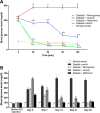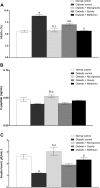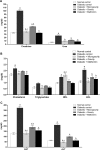Effect of simulated microgravity on the antidiabetic properties of wheatgrass (Triticum aestivum) in streptozotocin-induced diabetic rats
- PMID: 32133389
- PMCID: PMC7039905
- DOI: 10.1038/s41526-020-0096-x
Effect of simulated microgravity on the antidiabetic properties of wheatgrass (Triticum aestivum) in streptozotocin-induced diabetic rats
Abstract
Microgravity affects plant growth and content. A three-dimensional clinostat was used at 4 rotations/min to rotate the seeds of Triticum aestivum cultivar (Ammon) in three dimensions for 7 days, following which the antioxidant activities of ethanolic extracts were evaluated using both nitric oxide- and hydrogen peroxide-scavenging activities. The antidiabetic activities of ethanolic extracts were evaluated by measuring the concentration of plasma glucose, insulin, C peptide, and glycated hemoglobin (HbA1c); determining the number of β cells in the pancreatic islets; and performing the glucose tolerance test. Furthermore, the effects of the ethanolic extracts on the lipid profile and liver function were estimated. After rats were sacrificed, their pancreases were isolated and used for histopathological processing. The results indicated that the antioxidant potential and antioxidant metabolite content were significantly increased under microgravity conditions in comparison to those under normal gravity conditions. Rats treated with an extract of wheatgrass (T. aestivum) germinated over a period of 6-10 days under microgravity (WGM) showed a significant reduction in the levels of serum glucose, HbA1C, urea, creatinine, aspartate aminotransferase and alanine aminotransferase, and insulin resistance compared to rats treated with an extract of wheatgrass germinated under gravity. Additionally, the total cholesterol and low-density lipoprotein cholesterol levels were significantly decreased. In contrast, high-density lipoprotein cholesterol, C-peptide, and insulin levels rose significantly after treatment with T. aestivum germinated under microgravity. WGM is a promising potential diabetic treatment without side effects with a low manufacturing cost.
Keywords: Medicinal chemistry; Type 1 diabetes.
© The Author(s) 2020.
Conflict of interest statement
Competing interestsThe authors declare no competing interests.
Figures






Similar articles
-
Modulation of wheatgrass (Triticum aestivum Linn) toxicity against breast cancer cell lines by simulated microgravity.Curr Res Toxicol. 2023 Sep 19;5:100127. doi: 10.1016/j.crtox.2023.100127. eCollection 2023. Curr Res Toxicol. 2023. PMID: 37767028 Free PMC article.
-
Antidiabetic and Antioxidant Properties of Triticum aestivum in Streptozotocin-Induced Diabetic Rats.Adv Pharmacol Sci. 2013;2013:716073. doi: 10.1155/2013/716073. Epub 2013 Dec 14. Adv Pharmacol Sci. 2013. PMID: 24416041 Free PMC article.
-
Flavonoid-rich wheatgrass (Triticum aestivum L.) diet attenuates diabetes by modulating antioxidant genes in streptozotocin-induced diabetic rats.J Food Biochem. 2021 Apr;45(4):e13643. doi: 10.1111/jfbc.13643. Epub 2021 Feb 5. J Food Biochem. 2021. PMID: 33547672
-
Modulation of liver function, antioxidant responses, insulin resistance and glucose transport by Oroxylum indicum stem bark in STZ induced diabetic rats.Food Chem Toxicol. 2013 Dec;62:722-31. doi: 10.1016/j.fct.2013.09.035. Epub 2013 Oct 15. Food Chem Toxicol. 2013. PMID: 24140466
-
Healing effects of sumac (Rhus coriaria) in streptozotocin-induced diabetic rats.Pharm Biol. 2016 Oct;54(10):2092-102. doi: 10.3109/13880209.2016.1145702. Epub 2016 Mar 9. Pharm Biol. 2016. PMID: 26957014
Cited by
-
Mechanism for enhancing the growth of mung bean seedlings under simulated microgravity.NPJ Microgravity. 2021 Jul 15;7(1):26. doi: 10.1038/s41526-021-00156-6. NPJ Microgravity. 2021. PMID: 34267213 Free PMC article.
-
Evaluation of the Genetic Association and Expressions of Notch-2 /Jagged-1 in Patients with Type 2 Diabetes Mellitus.Med Arch. 2021 Apr;75(2):101-108. doi: 10.5455/medarh.2021.75.101-108. Med Arch. 2021. PMID: 34219868 Free PMC article.
-
Leiurus quinquestratus venom promotes β islets regeneration and restores glucose level in streptozotocin induced type 2 diabetes mellitus in rats.Sci Rep. 2025 Apr 7;15(1):11841. doi: 10.1038/s41598-025-94030-0. Sci Rep. 2025. PMID: 40195395 Free PMC article.
-
Wheatgrass inhibits the lipopolysaccharide-stimulated inflammatory effect in RAW 264.7 macrophages.Curr Res Toxicol. 2021 Feb 23;2:116-127. doi: 10.1016/j.crtox.2021.02.005. eCollection 2021. Curr Res Toxicol. 2021. PMID: 34345856 Free PMC article.
-
Modulation of wheatgrass (Triticum aestivum Linn) toxicity against breast cancer cell lines by simulated microgravity.Curr Res Toxicol. 2023 Sep 19;5:100127. doi: 10.1016/j.crtox.2023.100127. eCollection 2023. Curr Res Toxicol. 2023. PMID: 37767028 Free PMC article.
References
LinkOut - more resources
Full Text Sources

